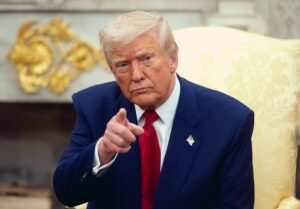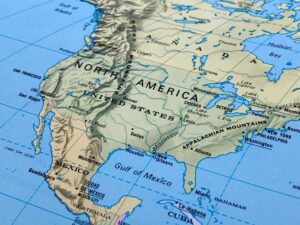Can Trump’s Reciprocal Trade Negotiations Make America Great Again?
On April 9, 2025, in the face of U.S. stock and bond markets spiraling downward, U.S. bond yields increasing, the dollar tanking, consumer confidence sinking, and growing nervousness among congressional Republicans, President Donald Trump “paused” his steep reciprocal tariffs just hours after they kicked in at 12:01 a.m. that day.
Notwithstanding the pause, the Trump administration announced increases in reciprocal tariff rates on China from 34 percent to 125 percent after China predictably struck back with retaliatory tariffs of its own. This increased the minimum U.S. tariff rate on most imports from China to around 170 percent (including the 125 percent reciprocal tariff, 20 percent fentanyl tariff, and the 25 percent to 100 percent Section 301 tariffs under the Trump 1.0 and Biden administrations, although at a certain point, tariff rates become prohibitive and further increases become largely meaningless.
However, just a day later, the president announced temporary exemptions for imports of semiconductors, smartphones, computer monitors, and various electronic parts from China, although this quickly evaporated with a Federal Register notice announcing that the Administration had initiated Section 232 investigations of semiconductors and pharmaceuticals on April 1.
The pause will not help President Trump’s negotiating leverage, since his resolve to tough it out in the face of steep market declines, foreign retaliation, and eroding congressional support is now uncertain. However, it was a prudent and probably necessary step as reciprocal tariffs were starting to affect retail prices in the United States; retaliatory tariffs from China and Canada were starting to hit; stiff EU tariffs were about to go into effect; and political support from congressional Republicans was starting to (at least privately) erode.
The pause also weakens incentives for U.S. and foreign firms to move manufacturing to the United States, since it prolongs the uncertainty as to whether firms would benefit from long-term tariff protection. A 10 percent baseline tariff is unlikely to be enough to trigger a “Golden Age” of new U.S. manufacturing and jobs, given the enormous switching costs most firms would incur and the time required to move production into the United States.
Read the Full Commentary Here
04/30/2025 | Warren Maruyama, Meghan Anand & William Alan Reinsch | CSIS
Harnessing New Investments In Industrial Policy To Advance North American Competitiveness
Meredith Lilly is a featured speaker in WITA’s upcoming event, “USMCA and North American Strategic Competitiveness.” Learn more here.
A key challenge facing greater North American economic regionalism is ongoing skepticism about the very idea of North America. This is hardly new. Despite decades of growing economic integration between the three countries, North America comes under constant criticism from within – especially by the United States. Robert Pastor outlined these challenges in his 2011 book, the North American Idea. More recently, Long and Bersin published the edited volume, North America 2.0, seeking to reenergize Pastor’s vision, and offer a practical blueprint for greater integration across a range of policy areas. In her book The Globalization Myth, Shannon O’Neil (2022) has made the compelling case that deeper regional integration does not represent a new phenomenon, but merely recognizes the trend that countries have already organized into major regional hubs, trading internationally but still relatively close to home. This is exemplified by the European Union and many Asian economies, who predominantly trade intra-regionally. O’Neil outlines the advantages that regionalism offers supply chains by reducing geographic distance, uncertainty and risk, as well as carbon emissions. She argues that the best path forward for the US is to further integrate with Canada and Mexico, to compete as a North American region that thrives internationally.
Yet, despite efforts to make the case for greater regionalization, North America has faced difficulties viewing itself as a region, with the U.S. its most “reluctant” member. Put more bluntly, the US has always pursued unilateralism in foreign and trade policy, even as it signed a trade agreement with Canada in the 1980s which was extended to Mexico via NAFTA in 1994. As McNeece puts it, the US situates itself at the centre of this trilateral relationship, and regards Mexico and Canada as suppliers to US interests. As the largest economy and most populous country in the region, the US has generally had the leverage to advance its interests in this manner, leaving neighbors to either align their respective policies with those of the US or be left aside. In the last decade, both Trump and Biden administrations have advanced their respective America First approaches, engaging at times in openly adversarial trade actions toward Mexico and Canada. This has made Canadian and Mexican public and private sector leaders nervous about the future reliability of their US neighbor as a trade partner, even as they seek to benefit from nearshoring opportunities that US unilateralism may present.
In addition, both Trump and Biden administrations have sought to deputize Mexico and Canada in American efforts to counter China’s rise. Yet, while there is a strong bipartisan consensus in the US on China, Canada and Mexico are less certain about the appropriate direction forward. Though Canada and Mexico are prepared to cooperate, they also need the US to include them in shaping a shared regional economic approach to China, and develop attractive alternatives for long-term, stable partnership within North America.
Read the Full Report Here
16/05/2024 | Meredith B. Lilly | Institute of The Americas
The Impact of US Tariffs on North American Auto Manufacturing and Implications for USMCA
Joshua P. Meltzer’s is a featured speaker in WITA’s upcoming event, “USMCA and North American Strategic Competitiveness.” Learn more here.
The current U.S. tariffs could increase investment in Canada and Mexico as a base for export. Proposed U.S. “reciprocal” tariffs on imports from a range of other countries—combined with continuing zero tariffs applied to USMCA consistent trade—will likely lead to even more investment in Canada and Mexico. As countries face higher U.S. tariffs, they will likely invest more in Canada and Mexico to produce goods for export to the U.S.
Canada and Mexico could also see increased investment by companies as a base for export globally. The extent to which this happens will depend on whether countries retaliate and raise tariffs on U.S. exports. When this happens it will create an incentive to export from Canada and Mexico to avoid tariffs that would apply when exporting from the U.S. Existing trade agreements between Canada, Mexico, and third countries also provides trade policy certainty and makes it unlikely that Canada and Mexico will face new tariffs. Canada currently has 15 free trade agreements, including with the United Kingdom, the EU, and countries within the Comprehensive and Progressive Agreement for Trans-Pacific Partnership. Mexico has 13 trade agreements, including with the EU, Japan, and members of the Central America-Mexico Free Trade Agreement.
The increase in U.S. tariffs on China increases the incentive for circumvention by China, and possibly other countries as well. Since the U.S. raised China tariffs in 2018, China was incentivized to circumvent these tariffs by entering the U.S. market via Mexico and Canada. This incentive is likely to grow as the U.S. expands and increases tariffs on imports from China. As noted, if the U.S. also implements “reciprocal” tariffs on other countries, this will create added incentives for these countries to also circumvent these tariffs by producing in Canada and Mexico for export to the U.S.
These developments in U.S. tariffs will have various implications for the upcoming USMCA review. The fact that Canada and Mexico were exempt from the April 2 reciprocal tariffs suggests that Trump is not looking to pull out of the USMCA, and that existing tariffs on Canada and Mexico may ultimately be used as leverage during the upcoming USMCA review…
Read the Full Research Here
05/13/2025 | Joshua P. Meltzer | Brookings Institution
To Tariff or Not to Tariff? Trump’s Trade War, Cross-Border Solidarity & the Fight Over the Future of North Atlantic Automaking
They say beauty is in the eye of the beholder. In President Trump’s eyes, “tariff” is “the most beautiful word in the dictionary.” In the short few months since his return to America’s highest office, President Trump has already waged an unprecedented tariff campaign, including a 25% tariff on imported cars and car parts. United Auto Workers (UAW) and their president Shawn Fain promptly endorsed this new tariff in an official statement, declaring that it will “end the free trade disaster that has devastated working class communities for decades.”
Beyond the economic cost of the tariff raised by many critics of the UAW’s endorsement, a more insidious long-term price demands particular scrutiny: the erosion of cross-border North Atlantic solidarity among auto workers. Most critically, this policy will upend the decades-long legacy of American and Canadian workers bargaining in solidarity together arm-in-arm across the border and undermine labor power throughout the North Atlantic auto industry.
A risky bet: conceding 80 years of cross-border North Atlantic solidarity for the gamble of “reshored” American auto jobs and rising prices
With 60% of parts going into American-made cars coming from across the border, any potential for these tariffs to “reshore” investment will need to contend with the preexisting dependence of domestic manufacturing on imported parts. This shift in the market will tack on an additional $3,000 to each American-made car, as one analyst put it: “bottom line: lower production, tighter supply and higher prices are around the corner.” But endorsing this tariff means not only justifying this tariff’s cost on American automaking supply chains, it also requires co-signing a taxation on unionized Canadian auto-workers who have organized, bargained, and struggled alongside the UAW for generations.
In 1937, it was the UAW itself which drove the initial unionization effort of Canadian auto workers after a massive GM plant strike erupted in Oshawa. After the first strike, the UAW trained organizers, led union drives across the country, and eventually accrued thousands of Canadian members over a series of years.
In the following decades, UAW leadership in the U.S. and Canada established the infrastructure necessary for maintaining robust labor power among Canadian and American auto workers, launching myriad cross-border bargaining units, developing strategic strike campaigns, and fostering a sense of trust and solidarity among members on both sides of the border.
In 1984, a disagreement over perceived capitulation to the Reagan Administration inspired the Canadian Auto Workers (later merging with Unifor) to branch off and establish their own labor organization. Despite the split in formal union affiliation, both the CAW and Unifor continued to organize, bargain, and work in solidarity with their brothers and sisters to the south, even when the manufacturing market shrunk. As one Wayne State Professor of labor studies put it: “They’re all part of the same industry. It’s not necessarily who is taking jobs from whom, it’s the same industry. No one is stealing from anybody. There’s shrinkage on both sides of the border.”
Given this legacy of cross-border solidarity enduring despite periods of stress in the North Atlantic auto industry, it is not surprising that the UAW’s endorsement of a policy that will burden the Canadian members of their sibling-unions shocked Canadian auto workers.
Read the Full Article Here
05/16/2025 | Liz Poulos | OnLabor
WITA – We put the community in trade community.
Information about upcoming WITA and trade community events






